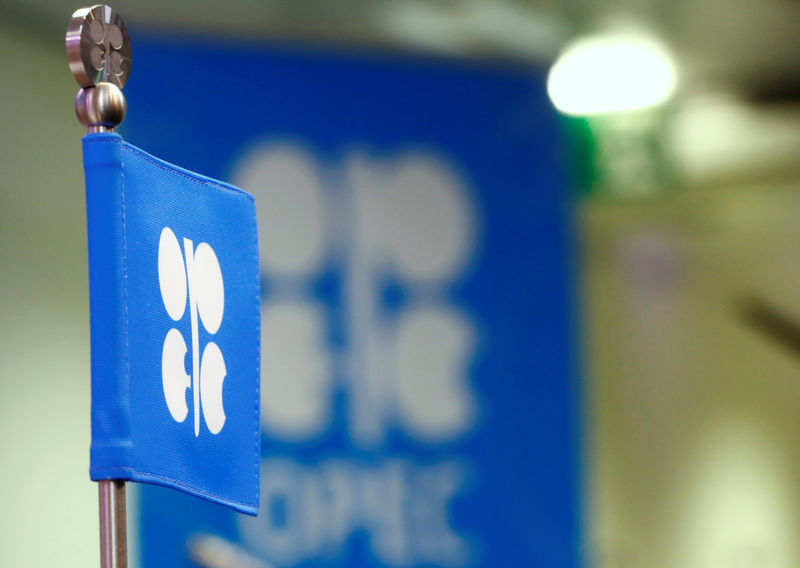* OPEC+ to ease output cuts by 2 mln bpd to 7.7 mln from Aug
* Global coronavirus cases cross 13.64 mln, death toll at
584,152
* China refinery output hits record in June
(Updates with settlement prices)
By Stephanie Kelly
NEW YORK, July 16 (Reuters) - Oil prices fell 1% on Thursday
after OPEC+ agreed to ease record supply curbs and as new
infections of the novel coronavirus continue to surge in the
United States.
Both benchmark Brent and U.S. crude have remained above $40
a barrel for the last several weeks. The Organization of the
Petroleum Exporting Countries and its allies, known as OPEC+,
lowered daily supply beginning in May and demand worldwide has
rebounding, helping prices to stabilize.
Fears of a second wave of cases of COVID-19 - led by the
United States - are keeping the rally in check. Nearly 600,000
people worldwide have died of the disease, according to a
Reuters tally. Brent LCOc1 fell 42 cents, or 1%, to settle at $43.37 a
barrel. U.S. West Texas Intermediate (WTI) crude CLc1 fell 45
cents, or 1.1%, to settle at $40.75 a barrel.
Both benchmarks rose 2% on Wednesday following a sharp
drawdown in U.S. crude inventories. EIA/S
International Energy Agency Executive Director Fatih Birol
said on Wednesday that global oil markets are rebalancing, with
prices of about $40 per barrel expected in coming months.
OPEC+ agreed on Wednesday to scale back oil production cuts
from August, reducing cuts by 2 million barrels per day to 7.7
million bpd through December. "Nobody could really expect OPEC+ to keep the 9.7 million
bpd curtailments into August," said Rystad Energy's senior oil
markets analyst Paola Rodriguez-Masiu. "Boosting output by 2
million bpd is not little, but the demand recovery, even though
a little slower than expected, justifies it."
Saudi Arabian Energy Minister Prince Abdulaziz bin Salman
said production cuts in August and September would end up
amounting to about 8.1 million-8.3 million bpd, more than the
headline number.
In a sign of recovery, China's refinery daily crude oil
throughput in June climbed 9% from a year earlier, reaching its
highest level on record due to rising consumption.
- English (USA)
- English (UK)
- English (India)
- English (Canada)
- English (Australia)
- English (South Africa)
- English (Nigeria)
- Deutsch
- Español (España)
- Español (México)
- Français
- Italiano
- Nederlands
- Português (Portugal)
- Polski
- Português (Brasil)
- Русский
- Türkçe
- العربية
- Ελληνικά
- Svenska
- Suomi
- עברית
- 日本語
- 한국어
- 简体中文
- 繁體中文
- Bahasa Indonesia
- Bahasa Melayu
- ไทย
- Tiếng Việt
- हिंदी
UPDATE 7-Oil falls as OPEC+ plans to raise output while virus cases increase
Published 07/16/2020, 12:53 PM
Updated 07/17/2020, 03:20 AM
UPDATE 7-Oil falls as OPEC+ plans to raise output while virus cases increase

Latest comments
Install Our App
Risk Disclosure: Trading in financial instruments and/or cryptocurrencies involves high risks including the risk of losing some, or all, of your investment amount, and may not be suitable for all investors. Prices of cryptocurrencies are extremely volatile and may be affected by external factors such as financial, regulatory or political events. Trading on margin increases the financial risks.
Before deciding to trade in financial instrument or cryptocurrencies you should be fully informed of the risks and costs associated with trading the financial markets, carefully consider your investment objectives, level of experience, and risk appetite, and seek professional advice where needed.
Fusion Media would like to remind you that the data contained in this website is not necessarily real-time nor accurate. The data and prices on the website are not necessarily provided by any market or exchange, but may be provided by market makers, and so prices may not be accurate and may differ from the actual price at any given market, meaning prices are indicative and not appropriate for trading purposes. Fusion Media and any provider of the data contained in this website will not accept liability for any loss or damage as a result of your trading, or your reliance on the information contained within this website.
It is prohibited to use, store, reproduce, display, modify, transmit or distribute the data contained in this website without the explicit prior written permission of Fusion Media and/or the data provider. All intellectual property rights are reserved by the providers and/or the exchange providing the data contained in this website.
Fusion Media may be compensated by the advertisers that appear on the website, based on your interaction with the advertisements or advertisers.
Before deciding to trade in financial instrument or cryptocurrencies you should be fully informed of the risks and costs associated with trading the financial markets, carefully consider your investment objectives, level of experience, and risk appetite, and seek professional advice where needed.
Fusion Media would like to remind you that the data contained in this website is not necessarily real-time nor accurate. The data and prices on the website are not necessarily provided by any market or exchange, but may be provided by market makers, and so prices may not be accurate and may differ from the actual price at any given market, meaning prices are indicative and not appropriate for trading purposes. Fusion Media and any provider of the data contained in this website will not accept liability for any loss or damage as a result of your trading, or your reliance on the information contained within this website.
It is prohibited to use, store, reproduce, display, modify, transmit or distribute the data contained in this website without the explicit prior written permission of Fusion Media and/or the data provider. All intellectual property rights are reserved by the providers and/or the exchange providing the data contained in this website.
Fusion Media may be compensated by the advertisers that appear on the website, based on your interaction with the advertisements or advertisers.
© 2007-2024 - Fusion Media Limited. All Rights Reserved.